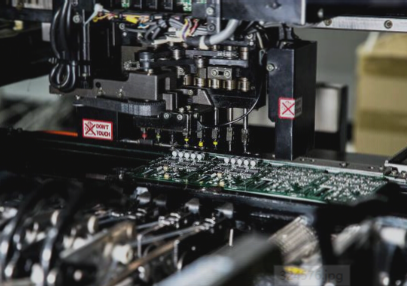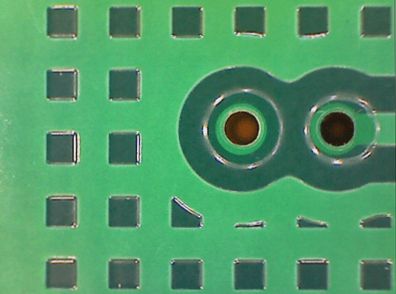1. The anti-paint serves to shield the assembly from moisture, dust, chemicals, and high temperatures in the operating environment where the electronic assembly is ultimately deployed.
2. When we need to remove or replace components due to field failures or manufacturing defects, we must first eliminate the coating that covers these components before proceeding with their removal and replacement.
3. It is crucial to choose the correct method for removing this coating to prevent damage to the PCB or adjacent components.
4. During the rework process, if the coating on the underside of the component is not entirely removed, the pad may detach from the circuit board when the component is taken out.
5. Incomplete removal of the coating can result in solder “splashing out” from the package during reflow in the rework process, potentially leading to a short circuit.
6. These issues, along with others, can arise from improper removal of the conformal paint.
7. There are several methods available for removing conformal paint from electronic assemblies.
8. The choice of method and materials for coating removal depends on the type, hardness, and size of the area needing treatment.
9. The most commonly used cleaning techniques include chemical stripping, mechanical peeling, heat scraping, mechanical scraping, and laser ablation.
10. Some coatings can effectively be removed using chemical solvents to

1. **Soften or partially dissolve these coatings.** The scavenger should be recommended by the paint manufacturer or formulated according to their guidelines. Following the manufacturer’s instructions can help minimize damage to the circuit board and components, but it is always advisable to test the scavenger on discarded circuit boards first. In many cases, masking the surrounding area allows for selective solvent application using cotton swabs. Once the coating material softens, you can gently remove it with a brush or wooden stick.
2. **In many instances, it is essential to add neutralizers around the clearing area to prevent the solvent’s ongoing effects.** If the scavenger chemicals are not thoroughly cleaned, ionic residues may remain on the circuit board, adversely affecting component reliability. Acrylic tri-proof paint is particularly sensitive to solvents, making it easier to remove using this technique. In contrast, silicone and polyurethane coatings are the least sensitive to cleaning solvents. Generally, solvent removal techniques are ineffective for epoxy resin and p-xylene.
3. **Certain conformal paints can be removed from the surface of PCB circuit boards and components through simple peeling or scraping.** You can utilize a toothpick, wooden stick, or sharp knife to remove these soft coatings. This mechanical removal method can be combined with heating or solvent techniques. Throughout this process, care must be taken to avoid damaging components and laminates. This cleaning technology is often employed to remove soft, silicone-based tri-proof paint or other flexible variants.
4. **Another coating removal technique involves using a heat source to soften or decompose the coating.** Typically, a heat gun or soldering iron serves as the heat source. Once the coating has softened, you can gently press with a dental tool or wooden stick to peel it off. This removal method is suitable for most conformal paints. Special attention must be given during heating to prevent damage to the laminate beneath the component or to adjacent components. This technique can effectively remove acrylic, epoxy, and silicone coatings.
5. **The micro-grinding coating removal method employs various soft abrasives to break down tri-proof paint through a nozzle accelerated by an inert gas.** A mixture of walnut shell, glass, plastic bead powder, and other powders is propelled onto the coating by the nozzle. The coating surface is gradually ground down by air pressure, and the nozzle’s removal directly impacts the process’s effectiveness. A source of ionized air is typically used to neutralize any electrostatic charge generated during this process. This method can remove coatings such as p-xylene, polyurethane, and epoxy-based materials from circuit boards.
6. **For precise removal of tri-proof paint, utilize a low-light source.** High energy density laser pulses gradually ablate the coating material. It is crucial to establish a laser source with the correct energy level and frequency, alongside multiple laser channels, to ensure only the coating is ablated without damaging the underlying material. The laser beam can target areas as small as a few microns, allowing for selective ablation of the paint. This method is effective for removing polyxylene paint.
7. **Visually inspect to confirm whether the tri-proof paint on the PCBA has been correctly removed from the designated areas.**
If you have any PCB manufacturing needs, please do not hesitate to contact me.Contact me
2. When we need to remove or replace components due to field failures or manufacturing defects, we must first eliminate the coating that covers these components before proceeding with their removal and replacement.
3. It is crucial to choose the correct method for removing this coating to prevent damage to the PCB or adjacent components.
4. During the rework process, if the coating on the underside of the component is not entirely removed, the pad may detach from the circuit board when the component is taken out.
5. Incomplete removal of the coating can result in solder “splashing out” from the package during reflow in the rework process, potentially leading to a short circuit.
6. These issues, along with others, can arise from improper removal of the conformal paint.
7. There are several methods available for removing conformal paint from electronic assemblies.
8. The choice of method and materials for coating removal depends on the type, hardness, and size of the area needing treatment.
9. The most commonly used cleaning techniques include chemical stripping, mechanical peeling, heat scraping, mechanical scraping, and laser ablation.
10. Some coatings can effectively be removed using chemical solvents to

1. **Soften or partially dissolve these coatings.** The scavenger should be recommended by the paint manufacturer or formulated according to their guidelines. Following the manufacturer’s instructions can help minimize damage to the circuit board and components, but it is always advisable to test the scavenger on discarded circuit boards first. In many cases, masking the surrounding area allows for selective solvent application using cotton swabs. Once the coating material softens, you can gently remove it with a brush or wooden stick.
2. **In many instances, it is essential to add neutralizers around the clearing area to prevent the solvent’s ongoing effects.** If the scavenger chemicals are not thoroughly cleaned, ionic residues may remain on the circuit board, adversely affecting component reliability. Acrylic tri-proof paint is particularly sensitive to solvents, making it easier to remove using this technique. In contrast, silicone and polyurethane coatings are the least sensitive to cleaning solvents. Generally, solvent removal techniques are ineffective for epoxy resin and p-xylene.
3. **Certain conformal paints can be removed from the surface of PCB circuit boards and components through simple peeling or scraping.** You can utilize a toothpick, wooden stick, or sharp knife to remove these soft coatings. This mechanical removal method can be combined with heating or solvent techniques. Throughout this process, care must be taken to avoid damaging components and laminates. This cleaning technology is often employed to remove soft, silicone-based tri-proof paint or other flexible variants.
4. **Another coating removal technique involves using a heat source to soften or decompose the coating.** Typically, a heat gun or soldering iron serves as the heat source. Once the coating has softened, you can gently press with a dental tool or wooden stick to peel it off. This removal method is suitable for most conformal paints. Special attention must be given during heating to prevent damage to the laminate beneath the component or to adjacent components. This technique can effectively remove acrylic, epoxy, and silicone coatings.
5. **The micro-grinding coating removal method employs various soft abrasives to break down tri-proof paint through a nozzle accelerated by an inert gas.** A mixture of walnut shell, glass, plastic bead powder, and other powders is propelled onto the coating by the nozzle. The coating surface is gradually ground down by air pressure, and the nozzle’s removal directly impacts the process’s effectiveness. A source of ionized air is typically used to neutralize any electrostatic charge generated during this process. This method can remove coatings such as p-xylene, polyurethane, and epoxy-based materials from circuit boards.
6. **For precise removal of tri-proof paint, utilize a low-light source.** High energy density laser pulses gradually ablate the coating material. It is crucial to establish a laser source with the correct energy level and frequency, alongside multiple laser channels, to ensure only the coating is ablated without damaging the underlying material. The laser beam can target areas as small as a few microns, allowing for selective ablation of the paint. This method is effective for removing polyxylene paint.
7. **Visually inspect to confirm whether the tri-proof paint on the PCBA has been correctly removed from the designated areas.**
If you have any PCB manufacturing needs, please do not hesitate to contact me.Contact me




